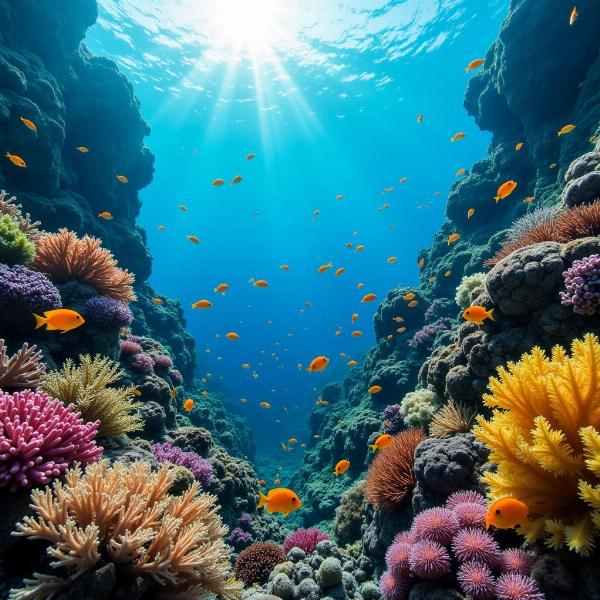Tropical zone meaning in Hindi is “उष्णकटिबंधीय क्षेत्र” (ushnakatibandhiya kshetra). This region, encompassing the area between the Tropic of Cancer and the Tropic of Capricorn, is known for its warm temperatures, abundant sunlight, and diverse ecosystems. Understanding the significance of this zone, its characteristics, and its impact on global climate is crucial. This article delves into the meaning of “tropical zone” in Hindi, exploring its geographical location, climate, biodiversity, and cultural influences.
Defining the Tropical Zone: उष्णकटिबंधीय क्षेत्र
The tropics, or the tropical zone, are defined by their geographical location. Lying between the Tropic of Cancer (23.5° N latitude) and the Tropic of Capricorn (23.5° S latitude), this region receives direct sunlight at least once a year. This direct sunlight results in consistent warmth, making it distinct from temperate and polar regions. “उष्णकटिबंधीय” (ushnakatibandhiya) directly translates to “hot belt,” aptly describing the characteristic climate of this zone.
Climate and Weather Patterns in the Tropical Zone
The tropical zone enjoys a warm climate throughout the year, with temperatures rarely falling below 18°C. However, the climate isn’t uniform across the entire zone. Rainfall varies significantly, creating distinct sub-climates like tropical rainforests, savannas, and deserts. Monsoon seasons are a defining characteristic of many tropical regions, influencing agricultural practices and cultural traditions.
What is the typical temperature in the tropical zone? The tropical zone generally experiences temperatures above 18°C year-round, with variations depending on specific location and altitude.
Biodiversity Hotspot: Rich Flora and Fauna
The tropical zone is renowned for its exceptional biodiversity. From lush rainforests teeming with life to vibrant coral reefs, it hosts a vast array of plant and animal species. The consistent warm temperatures and ample rainfall provide ideal conditions for numerous ecosystems to thrive. This region faces significant challenges due to deforestation and climate change, which threaten its unique biodiversity.
Cultural Influences and Human Impact
Human societies have thrived in the tropical zone for centuries, adapting to the unique climate and resources. Diverse cultures and traditions have emerged, deeply connected to the natural environment. Agriculture plays a vital role, with crops like sugarcane, rice, and bananas cultivated extensively. However, human activities, including deforestation and urbanization, have significantly impacted the delicate balance of these ecosystems.
How do monsoons affect life in the tropical zone? Monsoons play a crucial role in agriculture, water resources, and the overall rhythm of life in the tropical regions, bringing much-needed rainfall but also posing risks of flooding.
Tropical Zone’s Role in Global Climate
The tropical zone plays a vital role in regulating global climate patterns. The vast rainforests act as carbon sinks, absorbing significant amounts of carbon dioxide from the atmosphere. Ocean currents originating in the tropics influence weather patterns worldwide. Understanding the dynamics of the tropical zone is crucial for addressing global climate change challenges.
 Tropical Coral Reef Ecosystem
Tropical Coral Reef Ecosystem
Conclusion
The tropical zone, known as “उष्णकटिबंधीय क्षेत्र” (ushnakatibandhiya kshetra) in Hindi, is a crucial part of our planet. Its warm climate, rich biodiversity, and cultural significance make it a region of immense importance. Understanding the characteristics and challenges facing this zone is essential for both local communities and global efforts towards environmental conservation and sustainable development. By learning more about the tropical zone, we can better appreciate its unique contributions to our planet.
FAQ
-
What does “tropical” mean in Hindi? “Tropical” translates to “उष्णकटिबंधीय” (ushnakatibandhiya) in Hindi.
-
Where is the tropical zone located? The tropical zone is located between the Tropic of Cancer and the Tropic of Capricorn.
-
Why is the tropical zone important? The tropical zone is crucial for biodiversity, climate regulation, and cultural diversity.
-
What are the main threats to the tropical zone? Deforestation, climate change, and pollution are major threats.
-
How can we protect the tropical zone? Sustainable practices, conservation efforts, and reducing carbon emissions are key to protecting this vital region.
-
What are some examples of tropical fruits? Mangoes, bananas, pineapples, and papayas are common tropical fruits.
-
What are the major biomes in the tropical zone? Tropical rainforests, savannas, and deserts are major biomes within the tropical zone.
Related Articles on Meaning-Hindi.in
- tropical rainforest meaning in hindi
- monsoon trough meaning in hindi
- latitude in hindi meaning
- kayals meaning in hindi
About Meaning-Hindi.in
Meaning-Hindi.in is your trusted partner for professional Hindi translation services. We offer a wide range of translation solutions, including business and commercial document translation, certified and legal document translation, technical and user manual translation, website and localization services, educational and academic translation, express translation, and specialized industry translations. Need accurate and culturally sensitive translations? Contact us today! Email: [email protected], Phone: +91 11-4502-7584.